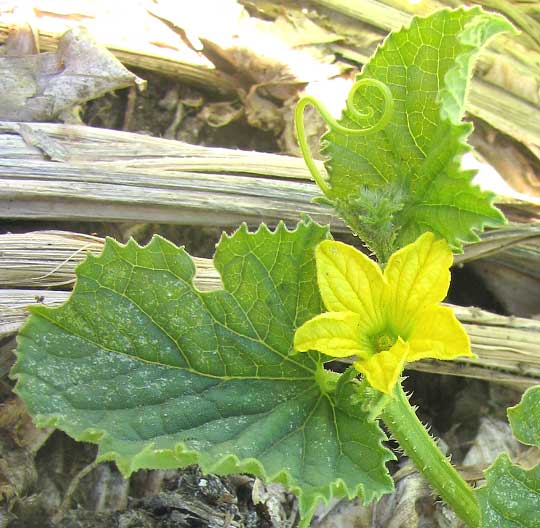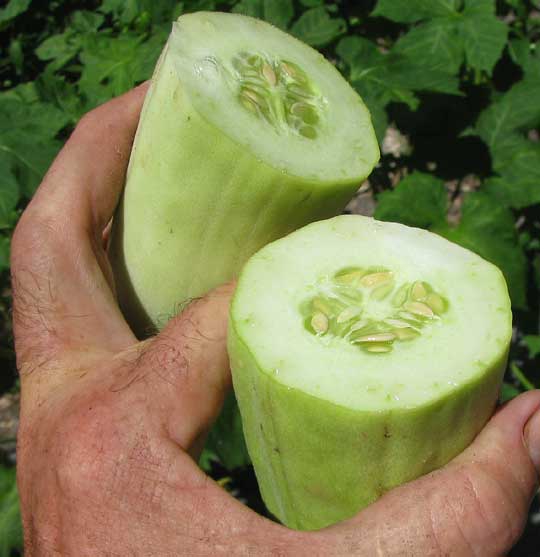Excerpts from Jim Conrad's
Naturalist Newsletter

from the October 17, 2010 Newsletter issued from Hacienda Chichen Resort beside Chichén Itzá Ruins, central Yucatán, MÉXICO; limestone bedrock, elevation ~39m (~128ft), ~N20.676°, ~W88.569°
"MAYA CUCUMBERS"
Often I've mentioned that the Maya plant their own locally developed seeds. Several months ago Don Philomeno spread numerous broad banana-tree leaves over a large garden area and planted inside the carpeted area several hills of cucumber. The banana leaves kept weeds from coming up and provided a clean surface for cucumbers to develop on. His crop reached is peak about a month ago and he harvested several bushels of cucumbers.
They were unlike any cucumber I'd ever seen. Everyone called them "pepinos," which means "cucumbers," so I called them that, too, though I fully expected that once I studied the matter they might turn out to be some kind of squash. You can see what one looks like at the top of this page.
That's a small one. Most of Don Philomeno's cucumbers were about two feet long (60 cm). He stopped watering them a while back, so now the leaves are drying up and just small fruits are forming. Sometimes up North if you overlook a regular cucumber in the garden it gets large and yellowish like these, but the Northern ones aren't ribbed longitudinally as these are. It's the ribs and lengths that distinguish our fruits.
But, are they really a cucumbers? One reason I wonder is because the Cucumber plant genus, Cucumis, arose in and is native to the Old World. But the squashes, genus Cucurbita -- with some species such as Zucchini looking cucumberish -- are American. Wouldn't any cucumber developed by the Maya be from an American genus? Two indications that our plants are Old World Cucumbers are seen below:

The first Cucumber Family fieldmark in the picture is the tendril, which is simple instead of branched. The vines of squashes and pumpkins bear branched tendrils while cucumbers bear unbranched or simple ones.
The second fieldmark for cucumber vines is the corolla, which is divided for more than half its total length. Squash and pumpkin flowers are more shallowly lobed. For comparison you can see a squash flower at www.backyardnature.net/fl_sqwsh.htm.
The main proofs that it's really a member of the Cucumber Family, however, become apparent when you cut a fruit open, as shown below:
 .
.
Not only does it look cucumbery but it tastes, smells and feels cucumbery.
But, it's not really a cucumber...
At this point you might be interested in visiting a web page showing several fruits known as cucumbers. It's at http://solanaseeds.netfirms.com/cucumbers.html.
Within the Squash/Cucumber Family, the genus Cucumis is home to both cucumbers and muskmelons. Regular cucumbers are Cucumis sativus, while muskmelons are Cucumis melo. It looks like our "Maya Cucumber" is, or is a derivation of, what often is known as the Armenian Cucumber, CUCUMIS MELO var. FLEXUOSUS. In other words, our "Maya Cucumber," despite its look, taste, odor and Spanish name, is much closer related to muskmelons than to regular garden cucumbers. If you think about, muskmelons are ribbed, too.
Don Philomeno's "cucumber" tends to be a bit shorter and thicker than those in most pictures of Armenian Cucumbers I find on the Internet, plus the ribs are farther apart and less prominent. Also our cucumbers don't grow as long and slender as Armenian Cucumbers, which also are called Snake Cucumbers, sometimes do. I'm guessing that Armenian Cucumbers were introduced into the Maya area soon after the Conquest, but during the last 500 years the variety has been altered by the Maya as they selected for plants best able to survive here.
Sometimes Armenian Cucumber seeds can be bought from companies specializing in selling heirloom seeds. I read that Armenian Cucumbers date back at least to the fifteenth century, when they were introduced into Italy from Armenia.
Here's the most important point about our "Maya Cucumber." Don Philomeno's vines -- planted during the rainy season like mine -- produced a bounty, while my North American garden-type vines succumbed to insects, nematodes and fungal diseases long before they ever produced.